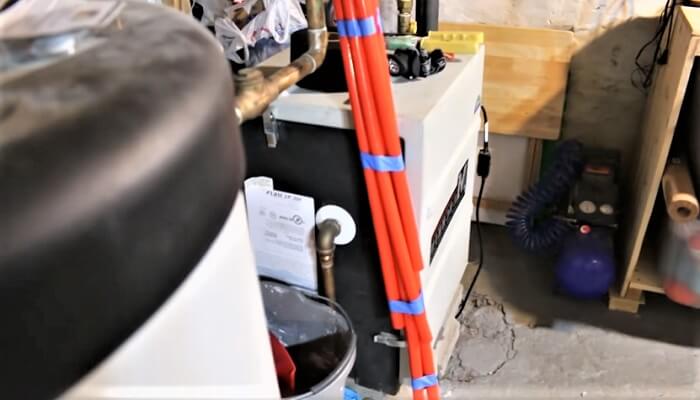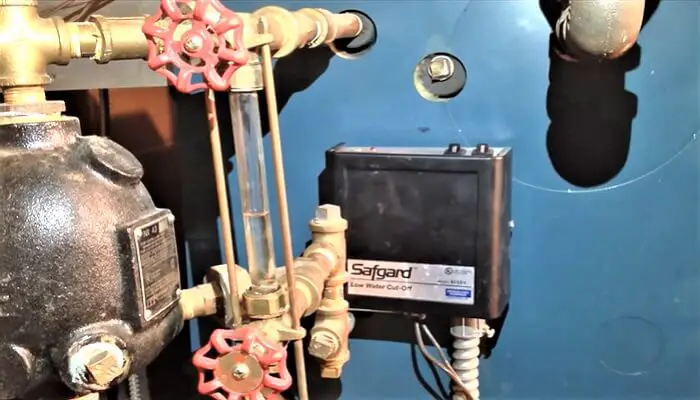| Note: This article may contain affiliate links, which means if you make a purchase following our links won’t cost you extra, but we may earn a commission. Learn more |
A steam boiler is a device that uses water to produce steam. Water is heated until it boils and the resulting steam is used to power turbines or engines.
A steam boiler, simply put, is a device that uses heat to generate steam. It is usually powered by natural gas or oil and can be used for a variety of purposes, from heating your home to powering large industrial plants.
A steam boiler works by heating water to its boiling point. It produces steam, which can be used to power various devices such as a steam engine. Steam boilers are very efficient, and can save you money on your energy bill. They are very versatile and can be used for different purposes.
They can be used to power steam engines, which are used in various industries, such as power generation, paper production, and textile production. Steam boilers can be used to heat your home or office.
Types of Steam Boilers
There are three types of boilers: fire-tube, water-tube, and once-through.
1. The fire-tube boiler consists of a series of tubes through which the hot gases from the burning fuel pass. The tubes are surrounded by water that is turned into steam by the heat of the gases. The most common type of fire-tube boiler is the locomotive boiler. Fire-tube boilers are most commonly used in residential and small commercial applications. They are also well-suited for applications where the steam demand is not constant.
2. The water-tube boiler consists of a number of small tubes through which hot water passes and turns into steam in contact with the tube walls. This type was first used in ships and later became popular in power plants because it could generate more steam per pound weight (or volume) than a fire tube boiler could at equivalent pressures. Water-tube boilers are more commonly used in large industrial and commercial applications where the steam demand is constant.
3. Once-through boilers are simple designs that consist essentially of one large pipe passing through a furnace where the fuel burns,. Water circulates inside this pipe and is heated to boiling point; as it does so it turns into steam and flows out at one end of the boiler as exhaust gas
Fire-tube boilers have combustion chambers and heat exchangers located in the same shell. Water-tube boilers, on the other hand, have their combustion chambers and heat exchangers located in separate shells.
How Does a Steam Boiler Work?
Steam boilers are the most common type of boiler used in the United States. Steam boilers work by heating water to its boiling point. This produces steam, which is then piped to radiators in the home. The steam radiates heat, warming the air in the room. The boiler then returns the water to its original state and begins the process again.

Fire-tube boilers are the oldest type of boiler. Fire-tube boilers have a steel shell that contains the water. The fire tubes, or flues, run through the shell to transfer heat from the fire to the water. Water-tube boilers are less common than fire-tube boilers. They are more efficient because they have a more direct path for the hot gases to transfer heat to the water.
Steam boilers are powered by a variety of fuel sources, including natural gas, propane, oil, and electricity. The type of fuel you use will determine the efficiency of the boiler and the cost of operating it. Natural gas is the most common fuel used to power steam boilers. It is also the most efficient.
What is a Steam Boiler Used for?
A steam boiler, simply put, is a container that holds water and is heated to produce steam. The heat can be generated in a variety of ways, such as by natural gas, propane, coal, oil, or biomass. The steam produced is used for a variety of purposes, such as powering turbines in a power plant, heating buildings, sterilizing equipment, and more.
Boilers are a critical part of many industrial operations and are found in a wide range of facilities, including power plants, chemical plants, paper mills, food processing plants, and more. They come in a variety of sizes, with some large enough to power a small city.
Steam boilers are an important part of the power generation and manufacturing industries, and they play a critical role in the global economy.
How to Bleed a Steam Boiler?
The best time to bleed your steam boiler is when the heating system is turned off and the boiler is cool. Before you start, make sure you have the following materials: a bleed key, a cloth or rag, and a bucket.
1. Insert the bleed key into the valve on the side of the boiler.
2. Turn the key clockwise until you feel resistance.
3. Hold the cloth or rag over the key to catch the water that will be released.
4. Open the valve by turning the key counterclockwise.
5. Allow the water to flow until it runs clear.
6. Close the valve by turning the key clockwise.
7. Remove the key and clothe or rag.
8. Check the pressure gauge to make sure the needle is in the green zone. If it’s not, add more water to the boiler. To learn more you can read this article.

Cleaning the Steam Boiler
A clean steam boiler must be maintained in order to produce high-quality steam, and it must be cleaned on a regular basis to prevent the build-up of dirt and other contaminants.
The components of a clean steam boiler include the water tank, burner, heat exchanger, and piping. The water tank holds the water that will be boiled into steam; the burner provides heat to boil the water; the heat exchanger transfers heat from combustion gases to water in order to create steam, and the piping conveys the team to its destination. All of these components must be kept clean in order to ensure that quality steam is produced.
It is important to clean your steam boiler on a regular basis to prevent it from becoming clogged with dirt and debris. If your boiler is not cleaned on a regular basis, it can become a fire hazard.
The first step in cleaning your steam boiler is to turn off the power to the unit. Next, you will need to remove the access panel to the boiler. Once the access panel is removed, you will have access to the boiler’s internals.
Next, you will need to disconnect the feed water line from the boiler. Once the feed water line is disconnected, you can begin the process of flushing the boiler. To flush the boiler, you will need to use a garden hose to run water through the unit.
Once you have finished flushing the boiler, you will need to reconnect the feed water line and turn the power back on to the unit. After the power is turned back on, you will need to bleed the air out of the system. To bleed the air out of the system, you will need to open the bleeder valve and allow the water to run until it is clear.
If you have any questions about how to clean your steam boiler, you should consult the owner’s manual for your specific model.
How to Maintain a Steam Boiler?
It is important to regularly maintain your steam boiler to prolong its life and prevent costly repairs. Below are some tips on how to maintain your steam boiler:
1. Check the level of water in the boiler on a daily basis. The water level should be between the minimum and maximum fill lines. If the water level is too low, adjust it and add more water. If the water level is too high, drain some water out.
2. Check the pressure gauge on the steam boiler monthly. The pressure should be 12 – 15 PSI (pounds per square inch). If the pressure is too low, add more water to the boiler. If the pressure is too high, bleed off some steam.
3. Inspect the boiler’s safety valve monthly. The safety valve should be open when there is no pressure in the boiler. If the safety valve is closed, open it and then close it again.
4. Test the boiler’s low-water cutoff monthly. The low-water cutoff is a safety device that shuts off the burner if the water level in the boiler gets too low. To test the low-water cutoff, slowly lower the float ball until the burner shuts off. Then, raise the float ball and turn the burner back on.
5. Inspect the boiler’s fire door monthly. The fire door should be tightly closed. If the door is not tightly closed, air will leak into the boiler and cause the fire to go out.
6. Inspect the boiler’s flue monthly. The flue should be clear of any obstructions. If the flue is blocked, the boiler will not draft properly and the fire will go out.
7. Clean the boiler’s fireside and waterside monthly. The fire side of the boiler should be free of soot. The water side of the boiler should be free of scale.
8. Have the boiler professionally serviced at least once a year.
By following these tips, you can prolong the life of your steam boiler and prevent costly repairs.

Steam Boiler Replacement
The hot water or vapor is created by burning fuel, usually natural gas, oil, or coal. The resulting heat is then used to produce steam, which flows through pipes and into radiators throughout the building.
As boilers lose their efficiency over time, steam boilers are often replaced when they reach the end of their lifespan – usually around 15-20 years. There are several reasons for this:
First, older boilers may not be as energy efficient as newer models;
Second, older boilers may be more prone to breaking down; and
Third, repairing an old boiler can sometimes be more expensive than replacing it altogether.
If you’re considering having your steam boiler replaced you should make sure you hire a qualified contractor who has experience with installing and servicing steam boilers.